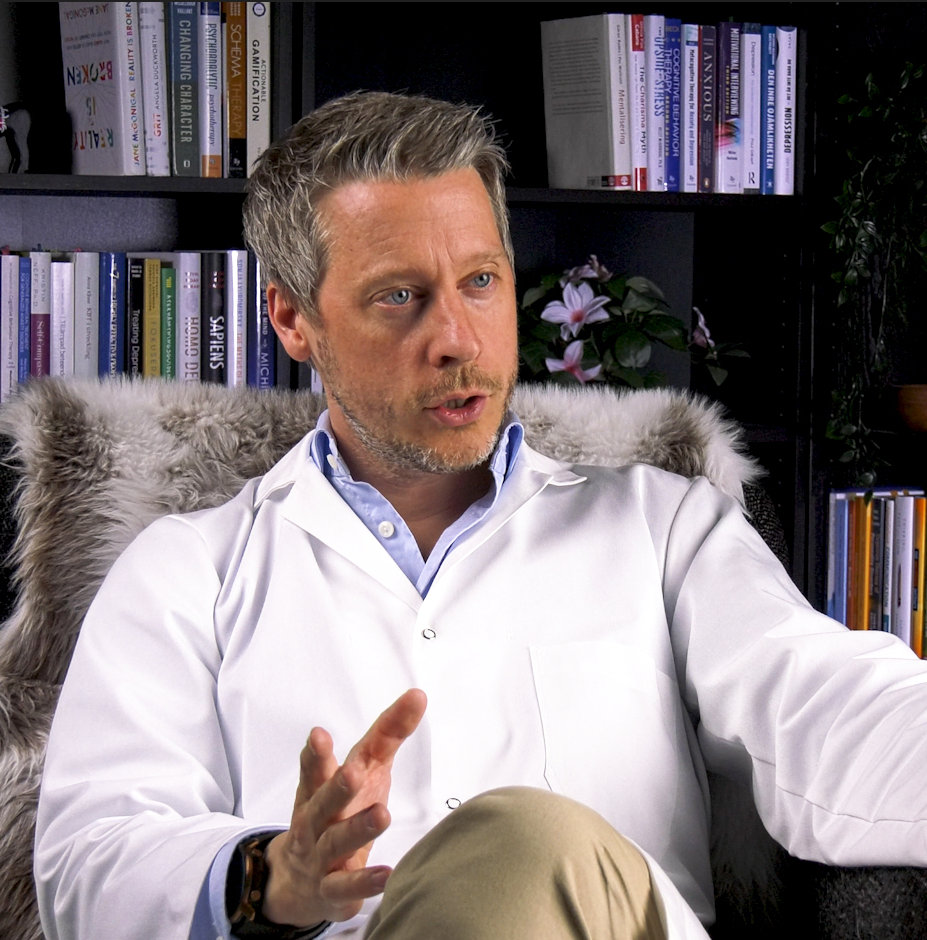You Don't Have to Live in Fear of the Next Panic Attack
Finally understand what’s happening during panic—and learn the tools used to work with panic
Evidence-based strategies from clinical practice
9 hours of expert-led video lessons
Learn at your own pace—no diagnosis needed
30-day money-back guarantee


The Fear That Follows You Everywhere
Your heart pounds. Your chest tightens. You can’t breathe. You rush to the ER. Tests come back normal. But the fear doesn’t leave.
Now you’re scanning your body constantly, avoiding places where escape feels difficult. Your world shrinks while everyone else’s stays the same.
You’ve tried breathing exercises, online articles, maybe even therapy. But you’re still stuck in the same exhausting cycle.
Here’s the truth: Panic attacks aren’t random. They follow specific patterns—and once you understand those patterns, you can finally respond differently.
What Happens If Nothing Changes?
Without the right understanding and tools, panic often gets worse over time:
- Your list of avoided places grows longer
- Fear of panic becomes as bad as panic itself
- Relationships suffer from constant cancellations
- Career opportunities pass you by
- Simple errands become major obstacles
- Anxiety about anxiety takes over your thoughts
The good news?
You can interrupt this cycle—starting today
What If You Could Finally Feel Without Fear?
Imagine waking up without checking how your body feels. Making plans without fear. Feeling confident again.
You’ll discover:
- Why your body reacts so intensely (and why it's not dangerous)
- The hidden triggers that keep panic coming back
- Tools psychologists use in therapy—step-by-step
- How to stop avoiding places you used to enjoy
- Long-term strategies so panic loses its power
This isn’t about quick fixes. It’s about understanding the root mechanisms of panic so you can build lasting freedom.
Everything You Need in One Program
38 Expert-Led Video Chapters
Almost 9 hours of structured content guiding you from fear to understanding to action.
Practical Worksheets
Track patterns, build exposure plans, and practice new strategies.

Real Clinical Stories
See yourself in these examples and understand that change is possible.
Lifetime Access
Revisit lessons whenever you need them
Evidence-Based Methods
Every technique is grounded in CBT and proven psychological approaches.
Replace fear with knowledge. Learn what happens in your brain and body during panic—and why it feels terrifying even though you're safe.
Uncover the biological, psychological, and behavioral loops that keep panic alive. Panic isn't random—it follows patterns you can change.
Learn exposure planning, breathing techniques, cognitive tools, and mindfulness strategies. Build your personal recovery plan.
Develop habits that strengthen your nervous system and prevent relapse. Get quick grounding tools for moments of crisis.
This Program Is for You If
No diagnosis needed. If panic is affecting your life, this can help.
1,000+ therapy sessions — now translated into a complete program
These words come from people I’ve supported in therapy over the years. This program was built on the same evidence-based methods that shaped those sessions — methods that have helped many find clarity, confidence, and relief in their everyday lives.
"Not the typical advice. He goes deeper and explain things in a way that makes sense. A life-changing journey.
"I can´t believe it. After just a couple of weeks I felt better than I had in years!"
OMG. I feel 90% better! I don´t want to jinx it, but this was such a relief.
Meet Your Guide
I’m Robert Bernhardsson, a licensed psychologist with over a decade of experience helping people overcome panic in clinical settings.
I’ve seen the same pattern repeatedly: people with panic feel dismissed, misunderstood, or given advice that doesn’t help.
That’s why I created this program—to make evidence-based psychological knowledge accessible to everyone who needs it.
Every module is grounded in Cognitive Behavioral Therapy and proven methods. Instead of waiting lists and expensive appointments, you get immediate access to clear, practical knowledge.
Important: This is a self-help educational resource, not a replacement for therapy or medical treatment.





Why Cognitive Behavioral Therapy Works for Panic
CBT is the gold standard treatment for panic disorder—backed by decades of research.
It works because it addresses:
- The thoughts that fuel panic
- The behaviors that maintain it
- The physical sensations that trigger it
- The avoidance patterns that strengthen it
This program translates clinical CBT into practical, step-by-step guidance you can follow independently.
Why This Is Different
You decide how fast or slow you want to go. Some people complete the program in a few weeks, others take several months.
The program is designed to be self-paced—you can learn, practice, and integrate each concept before moving forward.
You have lifetime access, so you can revisit any lesson whenever you need reinforcement.
It's Specific
Focuses exclusively on panic attacks and panic disorder—not general anxiety.
It's Clinical
Based on real therapeutic work with real clients who’ve overcome panic.
It's Immersive
Uses storytelling and real scenarios to make concepts stick.
It Goes Deeper
You’ll understand the neurobiology, psychology, and behavioral patterns—not just surface tips.
It's Flexible
Your pace, your schedule, your terms.
The Time Investment
9 hours of structured video content across 38 chapters.
Common Mistakes That Keep People Stuck
Avoiding everything that triggers fear
Avoidance strengthens panic. You’ll learn safe, gradual exposure instead.
Trying to “fight off” panic attacks
Resistance makes it worse. You’ll learn acceptance-based strategies.
Focusing only on symptoms
Without understanding the mechanism, symptoms keep returning. This program teaches you why panic happens.
Looking for quick fixes
Band-aid solutions don’t last. Real change requires understanding, which this program provides.
Special Introductory Pricing
One-time payment. No subscription. Full access.
What you get:
- All 38 chapters and 9 hours of video
- Downloadable worksheets and exercises
- Evidence-based strategies from clinical psychology
- Self-paced learning
- Lifetime access
- Email support for technical questions
- 30-day money-back guarantee
This Program Is NOT for Everyone
This won't help if you:
- Want an instant cure without any effort
- Aren't willing to practice new strategies
- Need immediate crisis intervention (call emergency services)
- Expect the program to replace medical treatment
- Want someone else to fix the problem for you
This WILL help if you:
- Want to understand what's really happening
- Are willing to learn and practice new tools
- Prefer self-paced, structured guidance
- Value evidence-based approaches
- Are ready to take an active role in your recovery
Your Questions Answered
This program is based on psychological principles proven in clinical practice. 30-day guarantee means risk-free.
It´s a self-guided educational resource teaching the same concepts used in therapy. Not a replacement for personalized treatment.
You´ll get a structured, psychology-based guidance specifically for panic—not generic advice. Sometimes it's about the right method at the right time.
Your choice. Many people see improvements in weeks, but results vary based on engagement, consistency, and individual conditions. You get full access from day one.
You get lifetime access to all lessons and materials, so you can revisit them anytime.
(Access remains available as long as the program is offered online.)
No. If you experience panic attacks, this program can help you.
30-day money-back guarantee. Just email [email protected] for a full refund.
What You'll Feel After Completing This Program
This isn’t just about managing panic—it’s about reclaiming your life.
Calm confidence in your ability to handle whatever comes.
Freedom to go anywhere without calculating escape routes.
Clear understanding of what panic is and how to respond.
Practical tools you can use anytime, anywhere.
Connection to your life and the people you care about.

Why Start Now?
CBT is the gold standard treatment for panic disorder—backed by decades of research.
Another day, avoiding places you used to love. Another day scanning your body for symptoms. Another day, letting panic make decisions for you.
But here’s the reality: panic doesn’t improve on its own. Without the right understanding and tools, it typically gets worse.
The good news? Change can start today. Right now. With this program.
For just $75, you get everything you need to begin understanding and addressing panic. No more waiting lists. No more expensive appointments. No more feeling stuck.
Imagine Life Without Constant Fear
That life is possible. Through understanding and practical tools that address the root of panic.
You’ve dealt with this long enough. You deserve relief.
Zero Risk, All Reward
30-Day Money-Back Guarantee
Try the program completely risk-free. If you don’t find it valuable, simply email [email protected] within 30 days for a full refund.
No questions asked. No hoops to jump through.
You have nothing to lose—and your freedom to gain.


Take the First Step Today
$75 gets you immediate access to everything you need to understand panic and start changing your relationship with it.
The knowledge you gain stays with you forever. The confidence you build transforms your life.
You don’t have to figure this out alone.
- One-time payment—no subscription
- 30-day money-back guarantee
- Instant access
- Introductory pricing—limited time
Still Not Sure?
Get a Free Miniguide
Join the newsletter to receive a free pdf guide on panic straight to your inbox. This miniguide includes a simple explanation of what actually happens during a panic attack and why it keeps happening.
